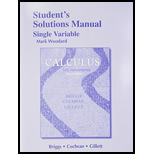
Concept explainers
Explain why or why not Determine whether the following statements are true and give an explanation or counterexample.
a. The
b. The differential equation y′y = 2t2 is first-order, linear, and separable.
c. The function y = t + 1/t satisfies the initial value problem ty′ + y = 2t, y(1) = 2.
d. The direction field for the differential equation y′(t) = t + y(t) is plotted in the ty-plane.
e. Euler’s method gives the exact solution to the initial value problem y′ = ty2, y(0) = 3 on the interval [0, a] provided a is not too large.
a.
Whether the given statement is true or false.
Answer to Problem 1RE
The given statement is False.
Explanation of Solution
The given statement is “The differential equation
It is known that order of a differential equation is the highest derivative present in the given differential equation.
Therefore, from the given differential equation observe that the highest order of derivative is 1.
Thus, the given differential equation is a first order differential equation.
Also, note that for a differential equation to be linear, the equation must not have products or quotients of y and its derivatives.
Thus, it can be concluded that the given differential equation is linear.
Now, check whether the given differential equation is separable or not.
From the above equation, note that the given differential equation is not separable as the variables cannot be separated further.
Therefore, the equation is in first order, linear but not separable.
Thus, the statement is false.
b.
Whether the given statement is true or false.
Answer to Problem 1RE
The statement is False.
Explanation of Solution
The given statement is “The differential equation
It is known that order of a differential equation is the highest derivative present in the given differential equation.
Therefore, from the given differential equation observe that the highest order of derivative is 1.
Thus, the given differential equation is a first order differential equation.
Also, note that for a differential equation to be linear, the equation must not have products or quotients of y and its derivatives.
Thus, from the given differential equation note that the equation consists of the product of the variable y and its derivatives.
Thus, the equation is not linear.
Now, check whether the given differential equation is separable or not.
From the above equation, observe that the variables can be separated.
Therefore, the equation is in first order, separable but not linear.
Thus, the statement is False.
c.
Whether the given statement is true or false.
Answer to Problem 1RE
The statement is true.
Explanation of Solution
The given statement is “The function
Take derivative on both sides of the equation
Now, substitute the value of
Therefore, the function
Thus, the statement is true.
d.
Whether the direction field for the differential equation
Answer to Problem 1RE
The statement “The direction field for the differential equation
Explanation of Solution
The given differential equation is
Note that the notation
Also, for the differential equation at each point
It is known that a direction field is a picture that shows the slope of the solution at
Therefore the direction field for the differential equation
e.
Whether the given statement is true or false.
Answer to Problem 1RE
The statement is false.
Explanation of Solution
The given statement is “The Euler’s method gives the exact solution to the initial value problem
The given initial value problem is
It is known that the direction fields are the basis for many Computer based methods for approximating solutions of a differential equation.
Also, the exact solution of the initial value problem at grid points is
Therefore, the goal is to compute a set of approximations to the exact solution at the grid points.
Therefore, the given assumption is false.
Thus, the statement is false.
Want to see more full solutions like this?
Chapter D1 Solutions
Student Solutions Manual, Single Variable for Calculus: Early Transcendentals
Additional Math Textbook Solutions
Thinking Mathematically (6th Edition)
A Problem Solving Approach To Mathematics For Elementary School Teachers (13th Edition)
Elementary Statistics (13th Edition)
Elementary Statistics
Basic Business Statistics, Student Value Edition
- Consider the functions f(x)=4x-1 and g(x)=sq root of -x+7. Determine 1. f o g(x) 2. Give the domain of f o g(x) 3. g o f (x) 4. Give the domain of g o f(x)arrow_forward12. lim h→0 √5x+5h -√5x h where x>0 is constaarrow_forwardLet f(x)=sq root of x+5 and g(x)=x2 -2. 1. The composite function g of f(x) = 2. The domain of g o f(x) in interval notation isarrow_forward
- Given f(x)=1/x-1 and g(x)=1/x+3, the domain of f(g(x)) in interval notation.arrow_forwardGood Day, Kindly assist with the following query. Regards,arrow_forwardExample 1 Solve the following differential equations: dy dx ex = 3x²-6x+5 dy dx = 4, y(0) = 3 x dy dx 33 = 5x3 +4 Prof. Robdera 5 -10:54 1x ㅁ +arrow_forward
- 21. First-Order Constant-Coefficient Equations. a. Substituting y = ert, find the auxiliary equation for the first-order linear equation ay+by = 0, where a and b are constants with a 0. b. Use the result of part (a) to find the general solution.arrow_forwardLet f be a function whose graph consists of 5 line segments and a semicircle as shown in the figure below. Let g(x) = √ƒƒ(t) dt . 0 3 2 -2 2 4 5 6 7 8 9 10 11 12 13 14 15 1. g(0) = 2. g(2) = 3. g(4) = 4. g(6) = 5. g'(3) = 6. g'(13)=arrow_forwardThe expression 3 | (3+1/+1) of the following integrals? A Ов E + + + + 18 3+1+1 3++1 3++1 (A) √2×14 dx x+1 (C) 1½-½√ √ ² ( 14 ) d x (B) √31dx (D) So 3+x -dx is a Riemann sum approximation of which 5 (E) 1½√√3dx 2x+1arrow_forward
 Linear Algebra: A Modern IntroductionAlgebraISBN:9781285463247Author:David PoolePublisher:Cengage Learning
Linear Algebra: A Modern IntroductionAlgebraISBN:9781285463247Author:David PoolePublisher:Cengage Learning
